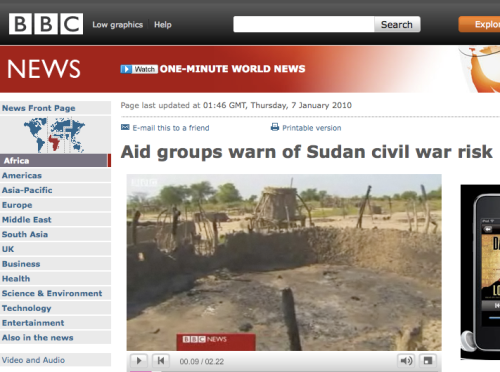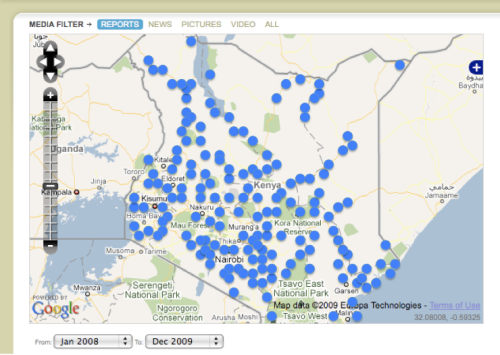By Tadakazu Kanno (PhD candidate, the Department of War Studies, King’s College London)
Patrick has already written about the impending violence regarding the coming elections in Sudan in this blog (“Sudan: An Early Warning of Impending Conflict”). I also came across a similar article posted on Alert Net, which is titled “West silent over Darfur crisis despite risk of spiraling violence”. In fact, this is not the first time I came across early warnings of election violence. The BBC’s article “Kenyans rearming for 2012 poll” (dated 07/October/2009) warns that “rival ethnic groups in Kenya who fought after the 2007 election are rearming in readiness for violence at the 2012 poll.” The International Crisis Group’s report (dated 01/October/2009) “African Peace-building Agenda: “Nigeria Needs to Prevent another Electoral Debacle” says that “Nigeria and its international friends need to act urgently and concertedly to prevent another electoral disaster in 2011.” The significance of the prevention of election violence is obvious if we look at the 2007 Kenyan post-election violence, which claimed over 1,000 lives and 300,000 people were displaced.
The source of the photo: the BBC (http://news.bbc.co.uk/1/hi/world/africa/8293745.stm)
Actually I wasn’t looking for these early warnings, I happened to find them. So it is possible to infer that there are plenty of early warnings regarding potential collective violence. In the field of early warning and early response, it is commonly accepted that there are plenty of warnings but the problem is that warnings are not followed by preventive actions (so called “warning-response gap”). About 15 years ago, Michael Lund was arguing in his book “Preventing Violent Conflicts” that:
“early warning occurred in several instances but did not precipitate any action. Strong expectations of potential conflict or even the outbreak of violence were not in themselves sufficient to generate preventive action. For example, fighting and grievous human rights violations in northern Somalia were widely reported by human rights organizations as early as 1988 yet provoked no response; International Alert disseminated a fact-finding report and recommendations regarding the Russia-Chechen disputes to the United Nations and other bodies in 1992, but no action followed; in the Danube River dispute between Hunagry and Slovakia, the disputants issued several requests for mediation assistance long before any third party stepped forward (p.81).”
David Nyheim’s report published in 2009, however, argues that :
“the field has evolved significantly since its initial conceptualization, and early warning has been integrated into the policies of many organizations. Today it cannot be said, however, that the international community is in a position to prevent another Rwandan genocide. Conflict early warning faces challenges similar to those it faced 15 years ago…(p.13)”
Are we going to repeat the same mistakes in those elections? There is good news from Burundi, where elections will also be held this year and people fear that violence regarding the upcoming elections may occur. The African Great Lakes Initiative (AGLI) of the Friends Peace Teams set up a community-based early warning and response project to prevent election violence (Burundi IT Election Warning Project). In the project, a wide network of monitors reports the symptoms of the tension between ethnic groups and violent incidents regularly by using mobile phones and they also plan to avert the tension on the ground through interventions. I’m happy that a civil society organisation started to take an initiative in election violence prevention.
But, we must understand that civil society is not an all-around player. Generally speaking, it may be difficult for civil society to prevent post-election violence by using an early warning and early response mechanism due to the following two reasons. (Although we must think about violence during election campaigns, I would like to focus on post-election violence).
- What civil society can utilize for their interventions is dialogue.
- The results of elections are not negotiable.
As you can imagine, “dialogue for something unnegotiable” is not easy. Most of the disputes between conflict parties are negotiable (it is the case especially at a community-level like the use of land), but the results of elections cannot be changed unless there was violation in election campaigns. If it is difficult for civil society to prevent post-election violence, it may be a good idea to work with law enforcement agencies who possess coersive power to stop violence. However, it is questionable that law-enforcement agencies function rapidly and impartially even if early warnings are wired to them. What is even worse is that they are actively involved in violence in some occasions. The International Crisis Group reports that in the 2007 Kenyan election violence, police officers have taken sides and used terror tactics.
Then, how can we enhance the capacity of civil society in early warning and especially in early response (interventions) to prevent election violence? In this regard, the vision of Burundi IT Election Warning Project is to the point:
“An alternative strategy is to address violence on the level at which it is carried out, building trust and relationships at the grassroots level that would weather possible calls for violence coming from political elites. Such relationships have prevented violence in communities in the past, as is evident from the regional variation in levels of violence as well as from the stories of the prevention of violence by local leaders and citizens who refuse to take part and encourage others to do similarly.
Such interventions are only possible, however, where people have been able to reconcile “ethnic” differences and healed the trauma in their hearts that is the basis of Hutu-Tutsi animosities. Otherwise, the “ethnic” division stirred up for political gain in an election falls on receptive ears and ready hands, motivated by frustration and anger or fear.”
What is significant, therefore, is to create an environment where calls for non-violence are heard and accepted by people even when politicians call for violence. This can be a platform for successful community-based early warning and early response (CBEWER) systems like Burundi IT Election Warning Project. It is a long term approach to create the environment by connecting people from different ethnic groups and enhancing inter-ethnic activities. Although it sounds natural, the greater people’s will for peace is, the greater the chance of success in conflict prevention is. CBEWER systems would function more effectively if they are established on the foundation of long term confidence-building approaches.
Burundi IT Election Warning Project is now collecting mobile phones. The collected mobile phones are going to be used by the field monitors in order to report violent incidents on the ground. By donating mobile phones, you can contribute to the prevention of election violence in Burundi. As I just introduced part of the project, if you like to get the whole picture of the project, please visit their website.








